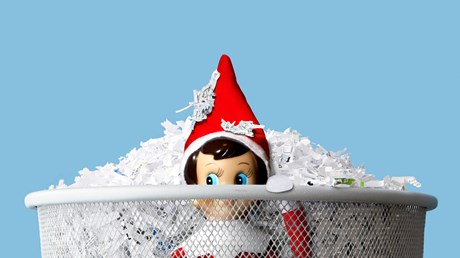God Doesn’t Use the Elf on the Shelf Method
It’s not the threat of divine surveillance but the extension of divine love that changes our hearts.

Around this time of year, some people argue about whether the baristas at their local coffee franchises should say “Happy Holidays” or “Merry Christmas.” Others argue about whether their churches should hang Christmas wreaths before the end of Advent. Still others focus on more hotly debated points—such as whether Die Hard is a Christmas movie or whether Mariah Carey’s “All I Want for Christmas Is You” is festive or annoying.
All the while, we are leaving unattended a debate that might tell us something about the state of American religion. I’m referring, of course, to the Elf on the Shelf.
Sold alongside a book of the same name, first published in 2005, the Elf on the Shelf is a plastic figure, bedecked in a long cap, that perches on the mantles (and various other spots) of some American homes. The elf is said to be a scout for Santa Claus, helping him determine who’s naughty and who’s nice. For some, the elf is uncannily eerie—the way creepy children in horror movies can be.
A decade ago, journalist Kate Tuttle argued in The Atlantic that the Elf on the Shelf is “a marketing juggernaut dressed up as a ‘tradition.’” She listed many reasons she hated the practice, but her most pointed one was the conceit behind the whole thing: teaching children that it’s all right to be spied on. The elf, after all, sits on his perch from Thanksgiving to Christmas to see whether kids keep the rules and behave.
While Tuttle might be right that there’s “something uniquely fake about the Elf,” the idea of controlling behavior with the notion that someone “sees you when you’re sleeping” and “knows when …